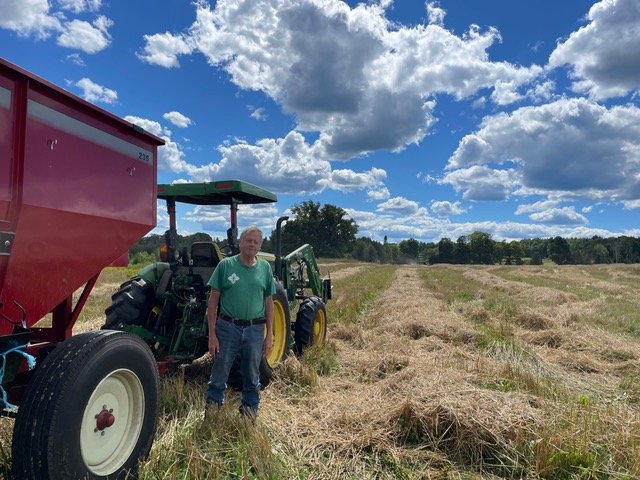
The bee hives are seen from Route 7 as you drive by, on the east side of the island of trees, which shields the bees from the winter winds. This picture looks south to Vergennes and Snake Mountain. The straps around the bee hives and solar-voltaic electric fence are there in case the bears get hungry. The bears can smell honey on a hot day for up to two miles. Hopefully the bears will not come near Routes 7 & 22A. We shall see. When you work with bees, you find out how many bears are in Vermont.
Angus keeps a distance from the bees.
Howie Vander Wey has hayed the land for years. Behind Howie, is where we will build the grain center. His family farms to the west of our land, across the railroad tracks. For years we had a bee yard on the Vander Wey farm with 30 and more hives. Ferrisburgh is one of the best towns in the Champlain Valley for nectar flow and pollen. The yellow flowers in the picture are birdsfoot trefoil, a legume that resembles a birdsfoot. Harry McDonald helped to develop birdsfoot trefoil at the Cornell Agriculture research station in the Champlain Valley of New York State. He was my favorite professor in ag school.
Howie Vander Wey
The glaciers left us with some of the best soil in the Champlain Valley for our waste water field. We dug test pits to confirm this and design our waste water systems. June 23, 2022: The grain center is being designed and built by a very dedicated team. Thank you all.
Looking at the test pits that we dug for a waste water system - L to R: Lisa Stevens, Vermont Agency of Natural Resources, Department of Environmental Conservation; Carl Cole, real estate agent, representing the Town of Ferrisburgh, who is selling us the land, and helping us through the long permit process; John Pitrowiski, Trudell Consulting Engineers, who guided us though the design, engineering and permit process for two years; Kyle Delphia, Delphia Excavating, dug the test pits with the backhoe in the background; Steve Delphia, Delphia Excavating, father of Kyle; Debra Townsend, Douglas Sweets who owns the lot north of the grain center and have it for sale. Angus
Patrick MacManaway & Angus
When it is time to locate water and drill a well, I first take a walk with Patrick MacManaway. Patrick and I walked on the land for the grain center, and he dowsed for water. He is marking the location where two underground streams cross. They are both 120 feet deep, one stream has a flow of 20 gallons per minute and the second stream flows at 30 gallons of water per minute. He asked for water that was high calcium and sulfate, and very little or no iron, which we felt was the best for whiskey. Partrick is from Scotland and knows whiskey. My great great grandfather left Scotland for the colonies on a sailing boat 205 years ago. His cousins stayed in Scotland and they were in the whiskey business for years, blending and distributing, the company J & W Hardie. The successors of this firm continue to make the “Antiquary”, still available in Scotland and the United States. Whiskey is important to the farm families of Scotland. Giving a value to grain helps make our farms thrive.
The first Amtrak passenger train is stopping at the Ferrisburgh-Vergennes station. July 29, 2022. The train goes from Burlington, Vermont to New York City each day and back again. You can park at the Park & Ride and walk west to the train station or east to the grain center.
“Thank you for your support of grain farming in Vermont.”
Todd Hardie







